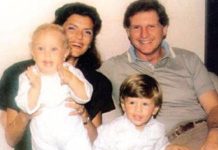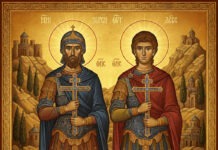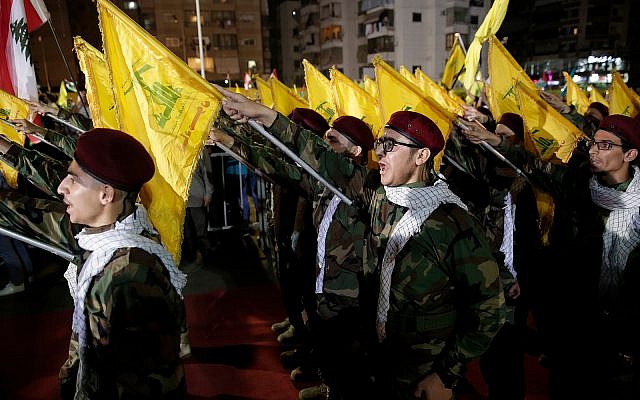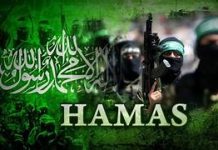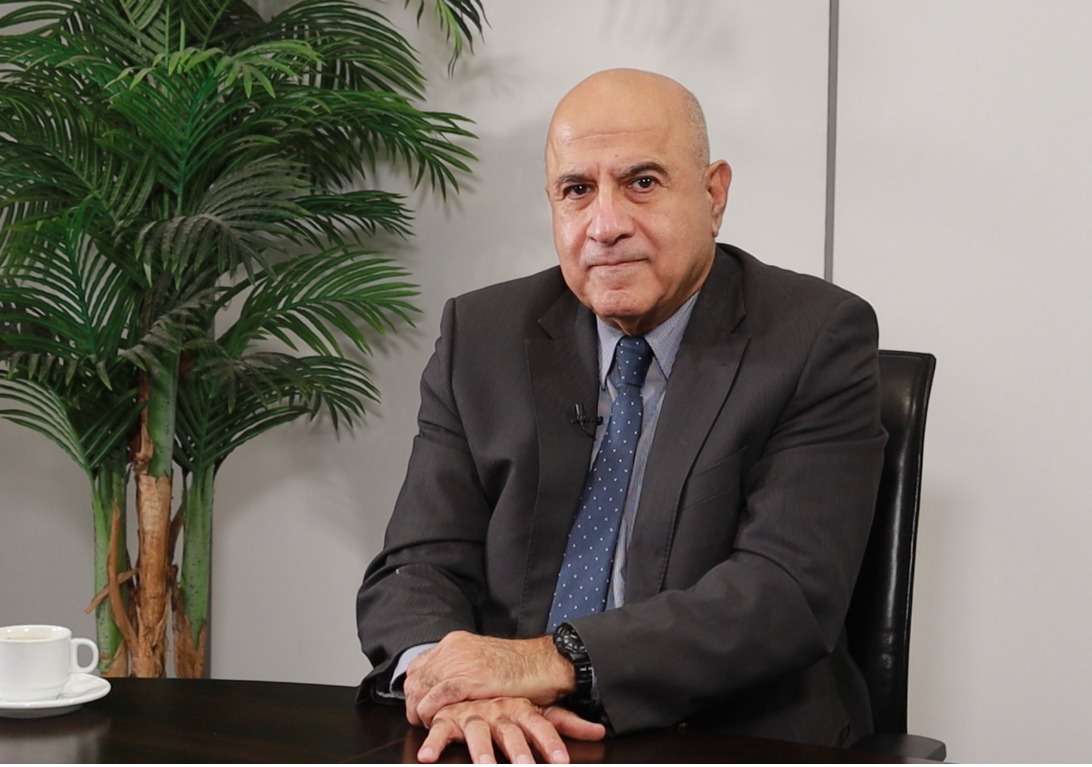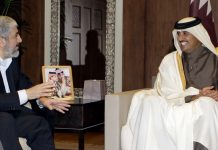Hezbollah’s new offensive – cutting holes in border fence raises tensions/Seth J. Frantzman/Jerusalem Post/May 02/2020
جيروزاليم بوست: تقطيعغ حزب الله أسلاك في السياج الحدودي يتسبب بتوتر مع إسرائيل
Germany’s Partial Ban of Hezbollah: A Half-Measure/Soeren Kern/Gatestone/Institute/May 02/2020
سورن كرين/معهد كايتستون: الحظرالألماني الجزئي لحزب الله هو نصف إجراء
Mossad gave Berlin intel on Hezbollah ops on German soil ahead of ban — report/The Timesw Of Israel & Agencies/May 02/2020
تايمز اوف إسرائيل: الموساد الإسرايلي زود المخابرات الألمانية بمواقع مخازن الأسلحة والمتفجرات التابعة لحزب الله في المانيا
***
Hezbollah’s new offensive – cutting holes in border fence raises tensions/Seth J. Frantzman/Jerusalem Post/May 02/2020
جيروزاليم بوست: اعتداءات حزب الله الحدودية بتقطيعه أسلاك في السياج الحدودي يتسبب بتوتر مع إسرائيل
Hezbollah knows that it is sitting on a powder keg, in a Lebanon that is financially strapped.
Bright, fading yellow lights hung in the air over northern Israel on Friday, April 17. They were illumination rounds fired after reports of activity along Israel’s border fence with Lebanon.
Residents in the North witnessed the flares. Soon images and video were being shared online.
“We found three locations where our security fence along the Blue Line with Lebanon was damaged tonight,” the IDF said.
Concerns and memories of past Hezbollah attacks meant there was a security alert along the northern border. No infiltration had occurred, though. Nevertheless, Israel viewed the incident as severe and held Lebanon responsible.
Three sections of the fence were damaged that evening. This was no ordinary damage by wild boar or a human error. It was also not an innocuous event, such as drug smuggling or some farmer lost near the border.
The next morning revealed propaganda posters showing late Hezbollah commander Imad Mughniyeh, Iran’s Islamic Revolutionary Guard Corps chief Qasem Soleimani and Iraqi Kataib Hezbollah leader Abu Mahdi al-Muhandis. Iran and Hezbollah have blamed Israel for killing Mughniyeh in Damascus in 2008, and the US killed Soleimani and Muhandis in a Baghdad airstrike in January. Whoever put up the poster wrote “Revenge” in Farsi with a hashtag. Iran has vowed “hard revenge” for the killings.
The posters were a message from Iran and its proxy Hezbollah. Sitting in his bunker, Hezbollah secretary-general Hassan Nasrallah was watching. His organization dominates on its side of the fence. It put the posters near the fence cuttings to send a message that it could breach the barrier.
On April 18, IDF soldiers repaired the fence near the border communities. In this area, Israeli communities sit right on the fence, within view of Lebanon. At Metulla, the northernmost community, Hezbollah posters and flags sit on hillsides across the border. Old bunkers from past wars are dug into the earth there. Bucolic fields dot the landscape, and Lebanese villages can be seen in the distance.
Several years ago, when Hezbollah was threatening attacks on Israel, it put up a poster showing the Dome of the Rock in Jerusalem, arguing that one day it would “liberate” al-Aksa.
This is Iran’s narrative. Tehran sees Israel and the US as its main enemies and vows to destroy the Jewish state. It has funded Hezbollah, sent precision-guided munitions and helped Hezbollah stockpile more than 150,000 rockets. Iran holds an annual “Quds Day” dedicated to Jerusalem, to express support for the Palestinians and oppose Zionism.
Hezbollah’s April message was part of a long context of tit-for-tat attacks and tensions along the border.
The terrorist movement appears to act with impunity inside Lebanon. It has hijacked the government in Beirut such that it holds enough seats and influence in parliament to make sure it can control who becomes president. It also now influences the Health Ministry. It carries out its own foreign policy, sending troops to fight in Syria and also sending Hezbollah members to Iraq to help corral pro-Iranian militias there. It runs smuggling operations across Syria to Iraq, and has put up bases and safe houses like mushrooms in Syria, including near Israel’s Golan border.
HEZBOLLAH WAS clearly riding high from the April border event. A journalist from Hezbollah-linked Al-Manar media took a photo near one of the fence cuttings on the border with Israel.
“Our brother Ali Soeib reporting one of the gaps in the bordering town east of Meis el-Jabal in Marjeyoun, Lebanon,” wrote supporters.
Other Lebanese journalists posed for selfies. Hezbollah and allies also filmed IDF soldiers repairing the fence. They also filmed a robot and drone next to the fence on the day after the cutting, as Israel tried to investigate several bags left behind near the openings. By midday two cuttings were repaired.
Foreign Minister Israel Katz ordered the ministry to file a complaint with the UN Security Council, asserting the fence cutting infringed upon Israel’s sovereignty. He told the UN that Jerusalem expects Lebanon’s government to prevent these kinds of threats to security. “The state of Israel thoroughly condemns these attempts to breach the border fence.”
Israel believes this incident threatens the entire region because incidents like these can lead to a wider conflict.
Iran was chuffed, with its Tasnim media bragging about the great threat Hezbollah poses to Israel, and portraying the operation as gallant, striking fear into the hearts of Israelis.
Some of this is just the usual Tehran bragging. Iran has been sending weapons to Hezbollah for years, but Israel has said that it has also carried out more than 1,000 airstrikes in Syria designed to curtail these efforts. In the first four months of 2020 the Syrian regime accused Israel of more than five airstrikes, at bases as far north as Homs and near Palmyra in the Syrian desert.
Iran, in turn, put out new photos of Ababil-3 drones, a flying machine with twin-tails, showing it carrying anti-tank smart bombs. Iran claimed it had “replicated” the bombs from Israeli Spike missiles. Iran also unveiled an anti-ship missile and launched a military satellite on April 22, claiming that now it has new strategic intelligence abilities.
For Hezbollah, of course, all this is good news; its main ally and backer is getting stronger.
The fence-line incident blended these tensions with some of the braggadocio that Lebanese Hezbollah uses to highlight its actions. Hardly a month goes by without Nasrallah giving a speech about how great his organization is and its far reach in the region.
Hezbollah has even sought to ally with the Iranian-backed Houthis in Yemen. The Houthis’ official slogan includes the term “death to Israel” and “curse the Jews, victory to Islam.” Of course, Hezbollah finds this attractive.
But Hezbollah also knows that it is sitting on a powder keg, in a Lebanon that is financially strapped.
For instance, Lebanon purposely made a show of force as the IDF repaired the fence. The same show of force was made in days prior to the fence cutting, as the IDF investigated other activity along the length of it. This was part of bubbling tensions. Lebanese social media spread rumors online that there was increased Israeli drone activity. Pro-Hezbollah activists termed the Hezbollah actions “brave” and a lesson to the “murderous” Israel’s “super fence.”
Hezbollah soldiers were like “ghosts,” these supporters said. Al-Akhbar media in Lebanon wrote a huge report about Hezbollah’s actions, detailing every aspect of the fence cutting.
The Akhbar report claimed that Hezbollah has returned with confidence to the border area. To confront what Hezbollah claimed was Israel’s use of drones and “dense enemy deployments and fixed military positions equipped with sophisticated monitoring and eavesdropping devices,” Hezbollah developed new methods. “The resistance,” as Hezbollah calls itself, sent cadres of fighters who were insulated from other Hezbollah operations in Iraq and Syria to the border with Israel to prepare for “day and night” activity confronting Israel.
Akhbar claimed Hezbollah monitored Israeli movements and Israel’s “high level of technical work” that is aimed at “preventing kidnappings and preventing infiltrations of [Israeli] settlements.”
Hezbollah “studied the additional options to respond to the assassinations or attempted assassinations of resistance fighters in Lebanon and Syria, which happened last week [April 15].”
The report makes it seem like Hezbollah felt this was some extraordinary special operation, with the “resistance” members watching the Friday sunset before setting off in three groups of “Islamic resistance advancing towards specific points on the fence with occupied Palestine.”
Along 34 km., Hezbollah teams acted to cut three holes, the movement claimed. One was near Avivim, another near the “colony of Metulla,” and a third near Meis el-Jabal close to the Manara cliff.
Hezbollah then watched the next day as “enemy snipers fired at the targets the resistance left behind.” Hezbollah seems to have chuckled at this, claiming they purposely left behind “useless wires and a broken cleaning machine [vacuum cleaner].”
Perhaps more serious is the claim in Akhbar that the size of the breach near Meis el-Jabal “exceeded six meters, allowing vehicles to cross into occupied Palestine in depth, not exclusively for infiltrating fighters.” This implies Hezbollah’s larger warning was that it could launch an invasion.
This conjures up memories from a trip to the same border area in Israel in June 2017, when locals said the next conflict with Hezbollah would be bloody. At the time, reports indicated border communities could be evacuated, and that Hezbollah would seek to grab territory as part of its initial attack.
We now know that Hezbollah built tunnels under the border. In December 2018 Israel launched Operation Northern Shield to root out the tunnels. I was on the border those nights as well, as Israel uprooted the threat.
HEZBOLLAH’S ATTEMPT to portray itself as “ghost-like” along the border is in stark contrast to some of its bumbling in Syria.
Along a pretty section of the Syria-Lebanon border, about a 40-minute drive from Damascus into the rolling hills that are north of Mount Hermon, Hezbollah men dashed from a Jeep Grand Cherokee on April 15. The usually quiet Syrian border village of Jdeidat Yabous, known mostly for Syrians crossing during the last nine years of Syrian civil war, was shattered with an explosion. The jeep’s back roof was torn up like a sardine can ripped apart.
According to reports, Mustafa Mughniyeh, son of the late Imad, was in the jeep with two colleagues when a missile fell next to it. Suspecting the next missile would hit them, they grabbed duffle bags and dashed from the vehicle. One man came back and got more items. Then the jeep exploded. Iranian media blamed Israel.
These incidents have a long background. Israel’s border with Lebanon has often been unstable. Israel invaded Lebanon in 1982 to stop Palestinians firing rockets at the North, leaving Lebanon in 2000 after years of war against Hezbollah. In 2006 Israel and Hezbollah fought a month-long war in the North that began with an attack on an Israeli patrol and kidnapping of bodies. Commander Imad Mughniyeh, a key conduit to Iran, was killed in Syria in 2008. Tensions grew with Hezbollah during the Syrian civil war, as Hezbollah played a larger role in Syria.
A strike by Hezbollah targeted Israeli vehicles near the border in 2015, after Imad Mughniyeh’s son Jihad was killed in an airstrike. Two Israeli soldiers were killed. Another attack targeting an IDF border patrol took place in January 2016. In August, after Israel killed a Hezbollah drone team in Lebanon, Hezbollah fired anti-tank rounds into Israel, destroying an IDF vehicle near Avivim.
For Hezbollah, this border is its cause and legacy. It says it is “resisting” Israel and claims it wants to retake areas Israel “occupies,” including a slice of territory – Mount Dov, aka Shaba Farms – north of Metulla. Hezbollah lives off its stories of confronting Israel, airing footage in 2019 of the 2015 attack as if to claim it could do it again.
The border incidents have a kind of clockwork about them. In each incident Hezbollah attempts to respond to what it claims is an Israeli action with a reaction. The airstrike on the vehicle on the Syria-Lebanon border on April 15 led to the fence cuttings. An incident in Beirut in August, in which Hezbollah claimed it downed an Israeli drone, led to the attack near Avivim last year. That, at least, is one narrative.
There have been other incidents as well. A Hezbollah member was killed near the Golan in the Syrian village of Khadr on February 27 and another Hezbollah member was gunned down in southern Lebanon in March.
Hezbollah threatens retaliation but is caught up in its own internal struggles at home in Lebanon. There is a budget crisis, and the organization does not appear to want to provoke war. It does want to show, via leaking information about its fence cutting, that it poses a threat.
Germany’s Partial Ban of Hezbollah: A Half-Measure/Soeren Kern/Gatestone/Institute/May 02/2020
سورن كرين/معهد كايتستون: الحظرالألماني الجزئي لحزب الله هو نصف إجراء
The ban is in fact a compromise measure between German lawmakers who want to take a harder line against Iran and those who do not. As a result, the ban falls far short of a complete prohibition on Hezbollah and appears aimed at providing the German government with political cover that allows Germany to claim that it has banned the group even if it has not.
According to the German Parliament, the Bundestag, a complete ban of Hezbollah is impossible because the group’s structures in Germany are “not currently ascertainable.”
It is utterly implausible that Germany, one of the wealthiest and most technologically advanced countries in Europe, is unable to ascertain the organizational structure of Hezbollah within its own borders. More plausible is that Germany wants to project a public appearance of cracking down on Hezbollah while maintaining direct access to its leadership.
“Your resolution has two central weaknesses. The first weakness is that you are asking for only an activity ban (Betätigungsverbot). We want a specific organizational ban (Organisationsverbot). According to the Crime Fighting Law (Verbrechensbekämpfungsgesetz) of 1994, the activity ban is the weaker legal means when compared to an organizational ban. There is no reason in the world why you would fight a terrorist organization with the weaker means and not the stronger.” — Beatrix von Storch, deputy chairwoman of the AfD parliamentary group in the German Bundestag.
“What is needed is the complete ban of Hezbollah. Hezbollah’s propaganda and terror financing in Germany must be stopped. The mosque associations that exist must be disbanded, and most importantly, Hezbollah supporters must be deported. This, by the way, is also demanded by the Bundestag’s Anti-Semitism Resolution, which expressly calls for the deportation of supporters of anti-Semitism. If this does not apply to supporters of Hezbollah, which wants to send Jews to the gas chambers, and wants to destroy Israel, then to whom could it apply?” — Beatrix von Storch.
“Today’s completely late action by the federal government is primarily a symbolic gesture. If the government were really serious about annihilating Hezbollah in Germany, it should have established a special commission and provided the security authorities with financial and human resources to identify and dismantle the group nationwide.” — Stefan Schubert, German security expert.
The German government, after years of equivocating, has announced what amounts to a partial ban on the Iran-backed Lebanese terrorist group Hezbollah. Pictured: Police in Berlin raid al-Irschad mosque, which is linked to Hezbollah, on April 30, 2020, following the announcement of the partial ban.
The German government, after years of equivocating, has announced what amounts to a partial ban on the Iran-backed Lebanese terrorist group Hezbollah — Arabic for “The Party of Allah” — in Germany.
The so-called ban — supported by the center-right Christian Democrats and the center-left Social Democrats, the two parties that make up Germany’s ruling coalition, and also by the classical liberal Free Democrats — has been hailed as “important,” “significant,” and “long overdue.”
The ban is in fact a compromise measure between German lawmakers who want to take a harder line against Iran and those who do not. As a result, the ban falls far short of a complete prohibition on Hezbollah and appears aimed at providing the German government with political cover that allows Germany to claim that it has banned the group even if it has not.
On April 30, the German government’s Federal Gazette (Bundesanzeiger) reported that Hezbollah was subject to an activity ban (Betätigungsverbot), but not an organizational ban (Organisationsverbot) — an important legal distinction because the activity ban is weaker than the organizational ban.
The two-page document, which carefully avoids referring to Hezbollah as a terrorist organization, prohibits the group’s logo to be displayed “in public, in meetings or in writings.” In addition, any assets that Hezbollah may have in Germany are to be confiscated.
The ban does not call for Hezbollah mosques or cultural centers to be closed, nor does it require that members of the group be deported. The ban also does not prohibit Hezbollah operatives from travelling to Germany.
After the so-called ban was made public, German Interior Minister Horst Seehofer ordered police to carry out raids on four mosques and cultural centers linked to Hezbollah: Berlin’s al-Irschad mosque, two cultural centers in Bremen and Münster, and a Lebanese community group in Dortmund.
Hezbollah, however, is believed to have more than 30 mosques and cultural centers in Germany, where the group is estimated to have upwards of 1,000 operatives, according to German intelligence assessments. It was not immediately clear why German police did not raid all of the mosques and cultural centers linked to Hezbollah.
In any event, the German government effectively gave Hezbollah at least four months to move its assets and operatives out of Germany. The newspaper Die Welt explained:
“It is still unclear what concrete effects the raids will have…. Berlin SPD politician Tom Schreiber suspects that Hezbollah was prepared for the searches. ‘I assume that an attempt was made to relocate assets and take people out of the country,’ Schreiber told Welt. ‘The question is, what exactly has the ban produced: what assets have been secured, what procedures have been initiated, what further information has been gained about the Hezbollah scene in Germany?'”
On December 19, 2019, the German Parliament, known as the Bundestag, approved a three-page resolution — “Effective Action against Hezbollah” (“Wirksames Vorgehen gegen die Hisbollah”) — that called on the German government to ban the activities of Hezbollah on German territory.
According to the Bundestag, a complete ban of Hezbollah is impossible because the group’s structures in Germany are “not currently ascertainable.” The Bundestag’s statement in the original German states:
“Hezbollah-related association structures, which could justify an organizational ban, are not currently ascertainable.” (“Der Hisbollah zuzurechnende Vereinsstrukturen, die ein vereinsrechtliches Organisationsverbot begründen könnten, seien derzeit jedoch nicht feststellbar.”)
The Deputy Chairman of the CDU/CSU parliamentary group in the Bundestag, Thorsten Frei, stated:
“Hezbollah-related association structures, which could justify an organizational ban (vereinsrechtliches Organisationsverbot), are not ascertainable, despite efforts by the federal government since 2008. An organizational ban is therefore not an option due to the lack of a verifiable domestic organizational structure. However, we are free to pursue an activity ban (Betätigungsverbot) that we have also applied to other terrorist organizations that lack a demonstrable domestic organizational structure.”
It is utterly implausible that Germany, one of the wealthiest and most technologically advanced countries in Europe, is unable to ascertain the organizational structure of Hezbollah within its own borders. More plausible is that Germany wants to project a public appearance of cracking down on Hezbollah while maintaining direct access to its leadership.
The idea to ban Hezbollah in its entirety originated with Germany’s conservative party, Alternative for Germany (Alternative für Deutschland, AfD), the third-largest party in the German parliament. The AfD has not been pleased with the partial ban. Addressing the German parliament on December 19, when the Bundestag called on the German government partially to ban Hezbollah, the deputy chairwoman of the AfD parliamentary group in the German Bundestag, Beatrix von Storch, explained:
“Six months ago, the AfD presented a resolution in the Bundestag to ban Hezbollah, a resolution which you vehemently rejected and which, since then, you have blocked in caucus. Now, six months later, you are collectively rushing through the door that we have politically opened. If this would happen with more AfD proposals, Germany would be in a much better place….
“Nevertheless, your resolution has two central weaknesses. The first weakness is that you are asking for only an activity ban (Betätigungsverbot). We want a specific organizational ban (Organisationsverbot). According to the Crime Fighting Law (Verbrechensbekämpfungsgesetz) of 1994, the activity ban is the weaker legal means when compared to an organizational ban. There is no reason in the world why you would fight a terrorist organization with the weaker means and not the stronger. You are making a loud bark, but you are not biting.
“The second fundamental weakness of your resolution is your justification for using the weaker means. You write, and I quote, ‘Hezbollah-related association structures, which could justify an organizational ban (vereinsrechtliches Organisationsverbot), are not ascertainable.’ That is objectively false, as confirmed by the 2017 and 2018 annual reports of Germany’s domestic intelligence agency (Bundesamt für Verfassungsschutz, BfV). The 2018 report states, and I quote, ‘In Germany, Hezbollah followers maintain organizational and ideological cohesion, among other things, in local mosque associations, which are primarily financed by donations.’ Do you even read your own intelligence reports? In case it is too long for you to read, it is located on page 214. Just check it!
“If you do not want to touch Hezbollah’s mosque associations, then this resolution is pure symbolism politics (Symbolpolitik), and symbolism politics cannot continue. What is needed is the complete ban of Hezbollah. Hezbollah’s propaganda and terror financing in Germany must be stopped. The mosque associations that exist must be disbanded, and most importantly, Hezbollah supporters must be deported. This, by the way, is also demanded by the Bundestag’s Anti-Semitism Resolution, which expressly calls for the deportation of supporters of anti-Semitism. If this does not apply to supporters of Hezbollah, which wants to send Jews to the gas chambers, and wants to destroy Israel, then to whom could it apply?”
On April 30, after the German government announced its half-measure against Hezbollah, von Storch said:
“Interior Minister Horst Seehofer has finally pushed through a ban on Hezbollah in Germany, which the Alternative for Germany (AfD) faction has been demanding for a very long time but was blocked in the Bundestag. The AfD welcomes Seehofer’s measures against the Hezbollah terrorist organization, although they are not sufficiently extensive. The AfD continues to demand that the Islamic terrorist organization be completely banned from organizing and we regret that our request in the Bundestag has been rejected. There is no place for Israel haters in Germany.”
The AfD’s Chairman in the Foreign Affairs Committee of the German Bundestag, Petr Bystron, added:
“This step was long overdue. The Federal Government has finally given in to pressure from the AfD parliamentary group. Hezbollah was allowed to do mischief in Germany for far too long: the Al-Quds March in Berlin demanded the destruction of Israel, speakers were allowed to spread their anti-Semitic agitation in Berlin and Hamburg.
“Now further steps must follow: Taxpayer support of anti-Israel Boycott, Divestment and Sanctions (BDS) organizations close to the SPD, the Greens and the Left, must end, as well as the taxpayer’s funding of the Hezbollah government in Lebanon and the Islamic terrorist regime in Tehran. We will now pay particular attention to the infiltration of German universities and public broadcasting by sympathizers of these terrorist organizations. The ‘ban on activity’ was only the first step. The fight goes on.”
On April 30, German Foreign Minister Heiko Maas tweeted:
“Hezbollah denies Israel’s right to exist, threatens violence and terror, and continues massively to upgrade its missile arsenal. In Germany we have to exhaust the rule of law to tackle Hezbollah’s criminal and terrorist activities.”
Maas, however, is one of Europe’s top supporters of Iran, which shares Hezbollah’s visceral hatred of Israel. On March 31, Maas proudly announced that European countries, led by Germany, had circumvented U.S. sanctions on Tehran.
The AfD’s concerns about Germany’s half-measures regarding Hezbollah are justified. The Kurdistan Workers’ Party (PKK), for instance, has been subject to an “activity ban” in Germany since 1993. Despite the ban, the PKK remains very active in Germany. The group had more than 14,500 members in Germany in 2020, according to German intelligence.
German security expert Stefan Schubert wrote that Germany’s partial ban on Hezbollah reflects a lack of political will to crack down on the group. He also predicted that the ban will likely have only a very small impact on Hezbollah’s activities in Germany:
“Today’s completely late action by the federal government is primarily a symbolic gesture. If the government were really serious about annihilating Hezbollah in Germany, it should have established a special commission and provided the security authorities with financial and human resources to identify and dismantle the group nationwide.”
The most immediate focus of the ban appears aimed at ending the annual anti-Israel Quds Day (Jerusalem Day) rally, originally scheduled to be held in Berlin on May 22, the last Friday of Ramadan. The annual rallies, held in cities around the world, are often attended by Hezbollah operatives and sympathizers waving the yellow Hezbollah flag and shouting anti-Israel slogans. After the German government announced its ban on Hezbollah, the organizers of this year’s rally in Berlin decided to cancel the event.
Worldwide, Britain, Canada, Israel, the Netherlands, the United States, the 22-member Arab League, the six-member Gulf Cooperation Council as well as Argentina, Colombia, Guatemala, Honduras and Paraguay have banned Hezbollah in its entirety.
The European Union, however, has resisted pressure to outlaw all of Hezbollah. European officials, who make an artificial distinction between Hezbollah’s military and political wing, regularly claim that a total ban might destabilize Lebanon’s political system, which is now dominated by the terrorist group. Others are worried that a complete ban of Hezbollah could hinder political and diplomatic efforts to salvage the now-defunct 2015 nuclear accord with Iran.
The European Union reluctantly banned Hezbollah’s “military wing” in July 2013, after the group was implicated in the July 2012 bombing of a bus carrying Israeli tourists in Burgas, Bulgaria. Five Israelis were killed in the attack.
Hezbollah officials, however, have repeatedly affirmed that the group operates as a single organization with a unified system of command and control. In a July 2013 interview with the German newsmagazine Der Spiegel, conducted immediately after the EU announced its partial ban on Hezbollah, the group’s spokesman, Ibrahim Mussawi, said:
“Hezbollah is a single large organization, we have no wings that are separate from one another. What’s being said in Brussels doesn’t exist for us.”
Hezbollah’s deputy secretary general, Naim Qassem, repeated that the group is structurally unified:
“We don’t have a military wing and a political one; we don’t have Hezbollah on one hand and the resistance party on the other…. Every element of Hezbollah, from commanders to members as well as our various capabilities, is in the service of the resistance, and we have nothing but the resistance as a priority.”
Qassem, in an interview with the Lebanese newspaper Al-Mustaqbal, said:
“Hezbollah has one single leadership, and its name is the Decision-Making Shura Council. It manages the political activity, the jihad activity, the cultural and the social activities. Hezbollah’s Secretary General is the head of the Shura Council and also the head of the Jihad Council, and this means that we have one leadership, with one administration.”
*Soeren Kern is a Senior Fellow at the New York-based Gatestone Institute.
© 2020 Gatestone Institute. All rights reserved. The articles printed here do not necessarily reflect the views of the Editors or of Gatestone Institute. No part of the Gatestone website or any of its contents may be reproduced, copied or modified, without the prior written consent of Gatestone Institute.
Germany’s Partial Ban of Hezbollah: A Half-Measure
Soeren Kern/Gatestone Institute/May 02/2020
سورن كرين/معهد كايتستون: الحظرالألماني الجزئي لحزب الله هو نصف إجراء
The ban is in fact a compromise measure between German lawmakers who want to take a harder line against Iran and those who do not. As a result, the ban falls far short of a complete prohibition on Hezbollah and appears aimed at providing the German government with political cover that allows Germany to claim that it has banned the group even if it has not.
According to the German Parliament, the Bundestag, a complete ban of Hezbollah is impossible because the group’s structures in Germany are “not currently ascertainable.”
It is utterly implausible that Germany, one of the wealthiest and most technologically advanced countries in Europe, is unable to ascertain the organizational structure of Hezbollah within its own borders. More plausible is that Germany wants to project a public appearance of cracking down on Hezbollah while maintaining direct access to its leadership.
“Your resolution has two central weaknesses. The first weakness is that you are asking for only an activity ban (Betätigungsverbot). We want a specific organizational ban (Organisationsverbot). According to the Crime Fighting Law (Verbrechensbekämpfungsgesetz) of 1994, the activity ban is the weaker legal means when compared to an organizational ban. There is no reason in the world why you would fight a terrorist organization with the weaker means and not the stronger.” — Beatrix von Storch, deputy chairwoman of the AfD parliamentary group in the German Bundestag.
“What is needed is the complete ban of Hezbollah. Hezbollah’s propaganda and terror financing in Germany must be stopped. The mosque associations that exist must be disbanded, and most importantly, Hezbollah supporters must be deported. This, by the way, is also demanded by the Bundestag’s Anti-Semitism Resolution, which expressly calls for the deportation of supporters of anti-Semitism. If this does not apply to supporters of Hezbollah, which wants to send Jews to the gas chambers, and wants to destroy Israel, then to whom could it apply?” — Beatrix von Storch.
“Today’s completely late action by the federal government is primarily a symbolic gesture. If the government were really serious about annihilating Hezbollah in Germany, it should have established a special commission and provided the security authorities with financial and human resources to identify and dismantle the group nationwide.” — Stefan Schubert, German security expert.
The German government, after years of equivocating, has announced what amounts to a partial ban on the Iran-backed Lebanese terrorist group Hezbollah. Pictured: Police in Berlin raid al-Irschad mosque, which is linked to Hezbollah, on April 30, 2020, following the announcement of the partial ban.
The German government, after years of equivocating, has announced what amounts to a partial ban on the Iran-backed Lebanese terrorist group Hezbollah — Arabic for “The Party of Allah” — in Germany.
The so-called ban — supported by the center-right Christian Democrats and the center-left Social Democrats, the two parties that make up Germany’s ruling coalition, and also by the classical liberal Free Democrats — has been hailed as “important,” “significant,” and “long overdue.”
The ban is in fact a compromise measure between German lawmakers who want to take a harder line against Iran and those who do not. As a result, the ban falls far short of a complete prohibition on Hezbollah and appears aimed at providing the German government with political cover that allows Germany to claim that it has banned the group even if it has not.
On April 30, the German government’s Federal Gazette (Bundesanzeiger) reported that Hezbollah was subject to an activity ban (Betätigungsverbot), but not an organizational ban (Organisationsverbot) — an important legal distinction because the activity ban is weaker than the organizational ban.
The two-page document, which carefully avoids referring to Hezbollah as a terrorist organization, prohibits the group’s logo to be displayed “in public, in meetings or in writings.” In addition, any assets that Hezbollah may have in Germany are to be confiscated.
The ban does not call for Hezbollah mosques or cultural centers to be closed, nor does it require that members of the group be deported. The ban also does not prohibit Hezbollah operatives from travelling to Germany.
After the so-called ban was made public, German Interior Minister Horst Seehofer ordered police to carry out raids on four mosques and cultural centers linked to Hezbollah: Berlin’s al-Irschad mosque, two cultural centers in Bremen and Münster, and a Lebanese community group in Dortmund.
Hezbollah, however, is believed to have more than 30 mosques and cultural centers in Germany, where the group is estimated to have upwards of 1,000 operatives, according to German intelligence assessments. It was not immediately clear why German police did not raid all of the mosques and cultural centers linked to Hezbollah.
In any event, the German government effectively gave Hezbollah at least four months to move its assets and operatives out of Germany. The newspaper Die Welt explained:
“It is still unclear what concrete effects the raids will have…. Berlin SPD politician Tom Schreiber suspects that Hezbollah was prepared for the searches. ‘I assume that an attempt was made to relocate assets and take people out of the country,’ Schreiber told Welt. ‘The question is, what exactly has the ban produced: what assets have been secured, what procedures have been initiated, what further information has been gained about the Hezbollah scene in Germany?'”
On December 19, 2019, the German Parliament, known as the Bundestag, approved a three-page resolution — “Effective Action against Hezbollah” (“Wirksames Vorgehen gegen die Hisbollah”) — that called on the German government to ban the activities of Hezbollah on German territory.
According to the Bundestag, a complete ban of Hezbollah is impossible because the group’s structures in Germany are “not currently ascertainable.” The Bundestag’s statement in the original German states:
“Hezbollah-related association structures, which could justify an organizational ban, are not currently ascertainable.” (“Der Hisbollah zuzurechnende Vereinsstrukturen, die ein vereinsrechtliches Organisationsverbot begründen könnten, seien derzeit jedoch nicht feststellbar.”)
The Deputy Chairman of the CDU/CSU parliamentary group in the Bundestag, Thorsten Frei, stated:
“Hezbollah-related association structures, which could justify an organizational ban (vereinsrechtliches Organisationsverbot), are not ascertainable, despite efforts by the federal government since 2008. An organizational ban is therefore not an option due to the lack of a verifiable domestic organizational structure. However, we are free to pursue an activity ban (Betätigungsverbot) that we have also applied to other terrorist organizations that lack a demonstrable domestic organizational structure.”
It is utterly implausible that Germany, one of the wealthiest and most technologically advanced countries in Europe, is unable to ascertain the organizational structure of Hezbollah within its own borders. More plausible is that Germany wants to project a public appearance of cracking down on Hezbollah while maintaining direct access to its leadership.
The idea to ban Hezbollah in its entirety originated with Germany’s conservative party, Alternative for Germany (Alternative für Deutschland, AfD), the third-largest party in the German parliament. The AfD has not been pleased with the partial ban. Addressing the German parliament on December 19, when the Bundestag called on the German government partially to ban Hezbollah, the deputy chairwoman of the AfD parliamentary group in the German Bundestag, Beatrix von Storch, explained:
“Six months ago, the AfD presented a resolution in the Bundestag to ban Hezbollah, a resolution which you vehemently rejected and which, since then, you have blocked in caucus. Now, six months later, you are collectively rushing through the door that we have politically opened. If this would happen with more AfD proposals, Germany would be in a much better place….
“Nevertheless, your resolution has two central weaknesses. The first weakness is that you are asking for only an activity ban (Betätigungsverbot). We want a specific organizational ban (Organisationsverbot). According to the Crime Fighting Law (Verbrechensbekämpfungsgesetz) of 1994, the activity ban is the weaker legal means when compared to an organizational ban. There is no reason in the world why you would fight a terrorist organization with the weaker means and not the stronger. You are making a loud bark, but you are not biting.
“The second fundamental weakness of your resolution is your justification for using the weaker means. You write, and I quote, ‘Hezbollah-related association structures, which could justify an organizational ban (vereinsrechtliches Organisationsverbot), are not ascertainable.’ That is objectively false, as confirmed by the 2017 and 2018 annual reports of Germany’s domestic intelligence agency (Bundesamt für Verfassungsschutz, BfV). The 2018 report states, and I quote, ‘In Germany, Hezbollah followers maintain organizational and ideological cohesion, among other things, in local mosque associations, which are primarily financed by donations.’ Do you even read your own intelligence reports? In case it is too long for you to read, it is located on page 214. Just check it!
“If you do not want to touch Hezbollah’s mosque associations, then this resolution is pure symbolism politics (Symbolpolitik), and symbolism politics cannot continue. What is needed is the complete ban of Hezbollah. Hezbollah’s propaganda and terror financing in Germany must be stopped. The mosque associations that exist must be disbanded, and most importantly, Hezbollah supporters must be deported. This, by the way, is also demanded by the Bundestag’s Anti-Semitism Resolution, which expressly calls for the deportation of supporters of anti-Semitism. If this does not apply to supporters of Hezbollah, which wants to send Jews to the gas chambers, and wants to destroy Israel, then to whom could it apply?”
On April 30, after the German government announced its half-measure against Hezbollah, von Storch said:
“Interior Minister Horst Seehofer has finally pushed through a ban on Hezbollah in Germany, which the Alternative for Germany (AfD) faction has been demanding for a very long time but was blocked in the Bundestag. The AfD welcomes Seehofer’s measures against the Hezbollah terrorist organization, although they are not sufficiently extensive. The AfD continues to demand that the Islamic terrorist organization be completely banned from organizing and we regret that our request in the Bundestag has been rejected. There is no place for Israel haters in Germany.”
The AfD’s Chairman in the Foreign Affairs Committee of the German Bundestag, Petr Bystron, added:
“This step was long overdue. The Federal Government has finally given in to pressure from the AfD parliamentary group. Hezbollah was allowed to do mischief in Germany for far too long: the Al-Quds March in Berlin demanded the destruction of Israel, speakers were allowed to spread their anti-Semitic agitation in Berlin and Hamburg.
“Now further steps must follow: Taxpayer support of anti-Israel Boycott, Divestment and Sanctions (BDS) organizations close to the SPD, the Greens and the Left, must end, as well as the taxpayer’s funding of the Hezbollah government in Lebanon and the Islamic terrorist regime in Tehran. We will now pay particular attention to the infiltration of German universities and public broadcasting by sympathizers of these terrorist organizations. The ‘ban on activity’ was only the first step. The fight goes on.”
On April 30, German Foreign Minister Heiko Maas tweeted:
“Hezbollah denies Israel’s right to exist, threatens violence and terror, and continues massively to upgrade its missile arsenal. In Germany we have to exhaust the rule of law to tackle Hezbollah’s criminal and terrorist activities.”
Maas, however, is one of Europe’s top supporters of Iran, which shares Hezbollah’s visceral hatred of Israel. On March 31, Maas proudly announced that European countries, led by Germany, had circumvented U.S. sanctions on Tehran.
The AfD’s concerns about Germany’s half-measures regarding Hezbollah are justified. The Kurdistan Workers’ Party (PKK), for instance, has been subject to an “activity ban” in Germany since 1993. Despite the ban, the PKK remains very active in Germany. The group had more than 14,500 members in Germany in 2020, according to German intelligence.
German security expert Stefan Schubert wrote that Germany’s partial ban on Hezbollah reflects a lack of political will to crack down on the group. He also predicted that the ban will likely have only a very small impact on Hezbollah’s activities in Germany:
“Today’s completely late action by the federal government is primarily a symbolic gesture. If the government were really serious about annihilating Hezbollah in Germany, it should have established a special commission and provided the security authorities with financial and human resources to identify and dismantle the group nationwide.”
The most immediate focus of the ban appears aimed at ending the annual anti-Israel Quds Day (Jerusalem Day) rally, originally scheduled to be held in Berlin on May 22, the last Friday of Ramadan. The annual rallies, held in cities around the world, are often attended by Hezbollah operatives and sympathizers waving the yellow Hezbollah flag and shouting anti-Israel slogans. After the German government announced its ban on Hezbollah, the organizers of this year’s rally in Berlin decided to cancel the event.
Worldwide, Britain, Canada, Israel, the Netherlands, the United States, the 22-member Arab League, the six-member Gulf Cooperation Council as well as Argentina, Colombia, Guatemala, Honduras and Paraguay have banned Hezbollah in its entirety.
The European Union, however, has resisted pressure to outlaw all of Hezbollah. European officials, who make an artificial distinction between Hezbollah’s military and political wing, regularly claim that a total ban might destabilize Lebanon’s political system, which is now dominated by the terrorist group. Others are worried that a complete ban of Hezbollah could hinder political and diplomatic efforts to salvage the now-defunct 2015 nuclear accord with Iran.
The European Union reluctantly banned Hezbollah’s “military wing” in July 2013, after the group was implicated in the July 2012 bombing of a bus carrying Israeli tourists in Burgas, Bulgaria. Five Israelis were killed in the attack.
Hezbollah officials, however, have repeatedly affirmed that the group operates as a single organization with a unified system of command and control. In a July 2013 interview with the German newsmagazine Der Spiegel, conducted immediately after the EU announced its partial ban on Hezbollah, the group’s spokesman, Ibrahim Mussawi, said:
“Hezbollah is a single large organization, we have no wings that are separate from one another. What’s being said in Brussels doesn’t exist for us.”
Hezbollah’s deputy secretary general, Naim Qassem, repeated that the group is structurally unified:
“We don’t have a military wing and a political one; we don’t have Hezbollah on one hand and the resistance party on the other…. Every element of Hezbollah, from commanders to members as well as our various capabilities, is in the service of the resistance, and we have nothing but the resistance as a priority.”
Qassem, in an interview with the Lebanese newspaper Al-Mustaqbal, said:
“Hezbollah has one single leadership, and its name is the Decision-Making Shura Council. It manages the political activity, the jihad activity, the cultural and the social activities. Hezbollah’s Secretary General is the head of the Shura Council and also the head of the Jihad Council, and this means that we have one leadership, with one administration.”
*Soeren Kern is a Senior Fellow at the New York-based Gatestone Institute.
© 2020 Gatestone Institute. All rights reserved. The articles printed here do not necessarily reflect the views of the Editors or of Gatestone Institute. No part of the Gatestone website or any of its contents may be reproduced, copied or modified, without the prior written consent of Gatestone Institute.
Mossad gave Berlin intel on Hezbollah ops on German soil ahead of ban — report/The Timesw Of Israel & Agencies/May 02/2020
تايمز اوف إسرائيل: الموساد الإسرايلي زود المخابرات الألمانية بمواقع مخازن الأسلحة والمتفجرات التابعة لحزب الله في المانيا
Unnamed Israeli official tells TV Germans were provided info on warehouses where terror group stashed materials for explosives, as well as money laundering networks
Israel’s Mossad spy agency gave information to Germany on Hezbollah’s activities on its soil ahead of the country banning the Lebanese terror group this week, Channel 12 news reported Saturday.
Germany branded the entirety of the Iranian-backed group — both the military and political wings — a “Shiite terrorist organization” on Thursday, with dozens of police and special forces storming mosques and associations across the country linked to the group.
According to the TV report, Israel carried out a months-long delicate operation to assess the group’s operations in Germany and presented its findings to German intelligence and law agencies.
Mossad reportedly gave Germany information about warehouses in the south of the country where Hezbollah stashed hundreds of kilograms of ammonium nitrate, a material used to make explosives.
Israeli intelligence was also said to have handed over details of key individuals in Hezbollah’s operations in Germany, including money networks used to launder cash and transfer millions of euros into the terror group’s bank accounts as well as to fund activities within the country.
An unnamed Israeli official told Channel 12 that the operation was complex and provided key evidence to German authorities.
“The move is the result of many months of work with all parties in Germany. The heads of services were required to present explicit evidence and legal proof… linking the organization to significant terrorist activity, and that is what we did,” the official said.
“Bruno Kahl, the head of the German intelligence organization BND, is a close friend of Mossad,” he added.
Germany on Thursday officially announced that it has outlawed activities by Hezbollah. In a dramatic departure from Berlin’s previous policy, which was based on the European Union’s stance, the new ban does not differentiate between the group’s military and political wings.
Hezbollah activities “violate criminal law and the organization opposes the concept of international understanding,” said German Interior Minister Horst Seehofer.
The group, headed by Hassan Nasrallah, denies Israel’s right to exist and “supports the armed terrorist fight” against the Jewish state, his ministry said in a statement issued Thursday. “It is to be expected that Hezbollah will continue to plot terrorist acts against Israel and Israeli interests also outside the Middle East.”
Early on Thursday, German police raided four groups associated with Hezbollah in various locations across the country to ensure that “evidence of potential sub-organizations in Germany could not be destroyed when this ban was announced,” the Interior Ministry said.
Since there is no formal German branch of Hezbollah, Berlin cannot outlaw the organization as such, according to an Interior Ministry statement. Hence the government undertook to ban Hezbollah’s activities, which has the same legal consequences, the statement explained: “It is prohibited to use or display symbols and to organize and participate in assemblies; assets are confiscated and forfeited. Violations of bans on organizations and activities are equally punishable.”
The new policy prohibits the showing of Hezbollah signs and symbols in public, including “in an assembly or in print, audio or visual media, pictures or portrayals.” Even the symbol of the Imam al-Mahdi Scouts, Hezbollah’s youth movement, is banned. The group’s assets will be confiscated.
Israel welcomed Berlin’s new policy. “It is a very important decision and a valuable and significant step in the global fight against terrorism,” Foreign Minister Israel Katz said in a statement released shortly after the decision was announced. “I would like to express my deepest appreciation to the German government for this step and I am sure that many governments in the Middle East as well as the thousands of victims of Hezbollah’s terror join in thanking them for this decision.”
Katz called on other European countries to follow the German move. “All the parts of Hezbollah, including the social, political and military wings, are terror organizations and they should be treated as such,” he said.
Prime Minister Benjamin Netanyahu praised Germany for the move and also called on other countries to follow suit. “Any country advocating peace needs to expel terror groups and not give them any direct or indirect support,” he said in a statement released by his office.
German authorities estimate that 1,050 people living in the country are affiliated with Hezbollah.
Iran on Friday slammed Germany’s ban on the activities of the Lebanese terrorist organization on its soil, saying it would face consequences for its decision to give in to the “propaganda machine” of Israel and US.
In a statement issued overnight, Iran’s foreign ministry said the Hezbollah ban ignores “realities in West Asia.”
The Islamic Republic said the move was based solely on the goals of the “propaganda machine of the Zionists and America’s confused regime.”
It “strongly” condemned the decision it said showed “complete disrespect to the government and nation of Lebanon, as Hezbollah is a formal and legitimate part of the country’s government and parliament.”
Iran said Hezbollah had a “key role in fighting Daesh’s terrorism in the region,” using the Arabic acronym for the Islamic State group.
“The German government must face the negative consequences of its decision in the fight against real terrorist groups in the region,” it added.
*Raphael Ahren contributed to this report.


